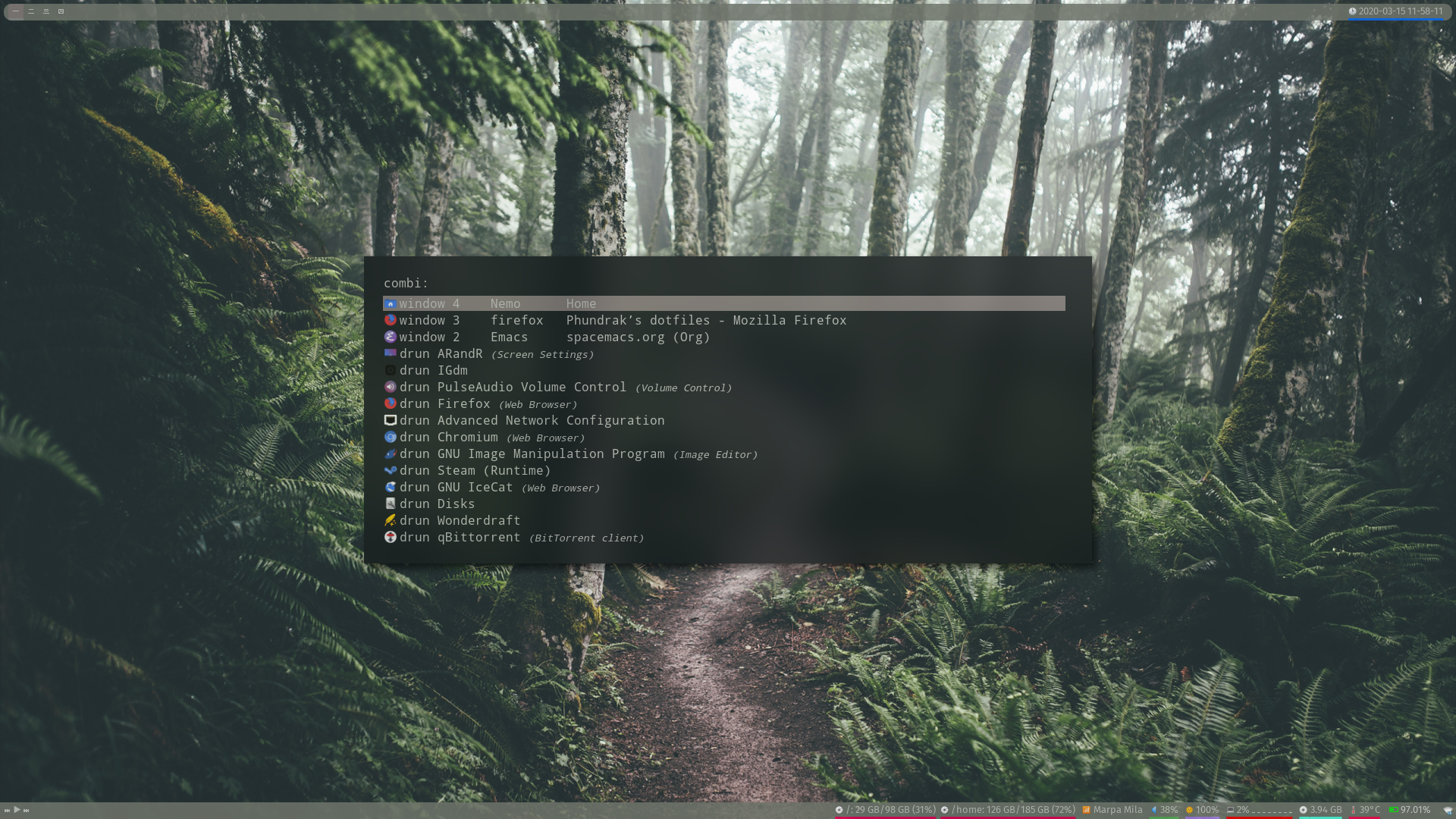12 KiB
Phundrak’s dotfiles
- Presentation
- Screenshots
- Features
- Dependencies
- Installation
- Licence
Presentation
This is my collection of dotfiles for my daily GNU/Linux environment, tweaked to my liking. If you wish to get the same setup as mine, follow the instructions below.
As you can see, I personally use fish as my shell of choice, and Emacs 27.0.90 (custom build) using Spacemacs (still with Emacs keybinding in Insert mode but with Evil in Normal mode) as my main text editor.
When it comes to my graphical UI, I do not have any desktop environment. Instead, I have two tiling window managers. The historical first on my configuration is i3-gaps, an i3 fork by Airblader with which I use two bars generated by Polybar. My other TWM, and the one I use most often, is AwesomeWM. Both TWMs use pywal to define their color scheme, as well as rofi’s color scheme.
Finally, you can find my configuration for my Ergodox keyboard here. It is optimized for usage with the Bépo layout set as a software layout, and for shortcuts from i3.
Screenshots



Features
- Emacs configuration perfectly tailored for my own use
- Beautiful and comfy i3 and polybar configuration
- And enough information below to get basically the same distro install as I have on my main computer and my travel laptop.
Most of the org files you will find in this repos are the actual source code
of much of my config files. For instance, the bootstrap found in
installation.org exports almost all of its code snippets to
.config/yadm/bootstrap thanks to M-x org-babel-tangle from within Emacs.
Below I will also present and comment some of my short config files which do
not deserve to have a full org file dedicated to them.
Tiling Window Managers
Graphical tweaks
Picom
Picom is a standalone compositor for Xorg, and the successor to Compton, itself successor to xcompmgr-dana, itself a fork of xcompmgr. You can find my Picom configuration here.
Xresources
My Xresources file is very short. Indeed, it only contains two lines which
are dedicated to my st terminal to set its font and shell. The font is set
as follows.
st.font: Source Code Pro for Powerline:style=bookAnd I will set my shell like this:
st.shell: /usr/bin/fishI can also set the transparency of st (my terminal emulator) like so:
st.alpha: 0.7I used to have lines dedicated to UXTerm and URxvt, but I cast them out of my system.
Text and source code editing
Emacs configuration
Emacs is my main text editor, which I use for almost everything. Because, you know…
Emacs is a great operating system, it just lacks a good text editor.
You can find my Emacs config, based on Spacemacs, in my .spacemacs file, and my user configuration in my spacemacs.org file.
Nano
Although it is a very simple piece of software, nano does offer some customization. Mine can be found in my nano.org file.
Rustfmt
You can find my Rustfmt configuration here.
Custom scripts in PATH
I have written some scripts that help me daily accomplish some simple tasks, like mounting and unmounting a drive or Android device, an emoji picker, a utility to set up my Wacom tablet, and so on. You can find them stored in .local/bin along with their detailed explanation in the README placed in the same folder —which is actually their source code once the org-mode file gets tangled.
Fish configuration with useful abbreviations
You can also find in my Fish shell configuration in my fish.org file, which contains my usual abbreviations.
And some minor configuration files
Email signature
This file gets inserted automatically at the end of my emails.
Lucien “Phundrak” Cartier-Tilet
https://phundrak.com (Français)
https://en.phundrak.com (English)
Sent from a Free and Open-Source Linux operating system with GNU/EmacsGlobal gitignore
Sometimes, there are some lines that always reappear in gitignores. So, instead of always adding them, let git now that some elements are to be ignored by default, hence the ~/.gitignore_global file. First, we don’t want nano’s backup files.
~*
And object files and output binaries generated by gcc and the likes aren’t
welcome either.
,*.out
,*.oTmux configuration
You can find my tmux configuration in tmux.org. It depends on the submodule .tmux by Gregory Pakosz.
Dependencies
Of course, some dependencies are needed for my dotfiles to work well. Here is a non-exhaustive list of software needed by these configuration files:
-
GNU/Emacs >= 26.2
- Spacemacs (develop branch)
- My conlanging layer
- Venmos’ w3m layer
- The Fish shell, using fisher
- Luke Smith’s fork of st
- Resloved’s i3-gaps-rounded fork of Airblader’s i3-gaps, itself a fork of i3
- Compton, more specificaly Tryone’s fork
- pywal
- dmenu
- j4-dmenu-desktop
- Rofi
- minted
- Rust (stable and nightly)
- LaTeX and XeTeX (
texlivepackages on Arch Linux) - tmux, based on this repo’s configuration by Grégory Pakosz.
- And a bunch of other stuff, see below
And some other stuff scattered around in my dotfiles.
BTW, I use Arch.
Installation
For an installation walkthrough of my Arch Linux installation, check out my installation.org file where I walk you through the first manual steps and through the bootstrap you can execute to automatically take care of a lot of elements.
Licence
All of my dotfiles (and my dotfiles only) are available under the GNU GPLv3 Licence. Please consult /phundrak/config.phundrak.com/src/commit/5453b8bc5ece25758f2c43381164fbfc2e143ed9/org/config/LICENCE.md for more information. In short: you are free to access, edit and redistribute all of my dotfiles under the same licence and as allowed by the licence, and if you fuck up something, it’s your own responsibility.
